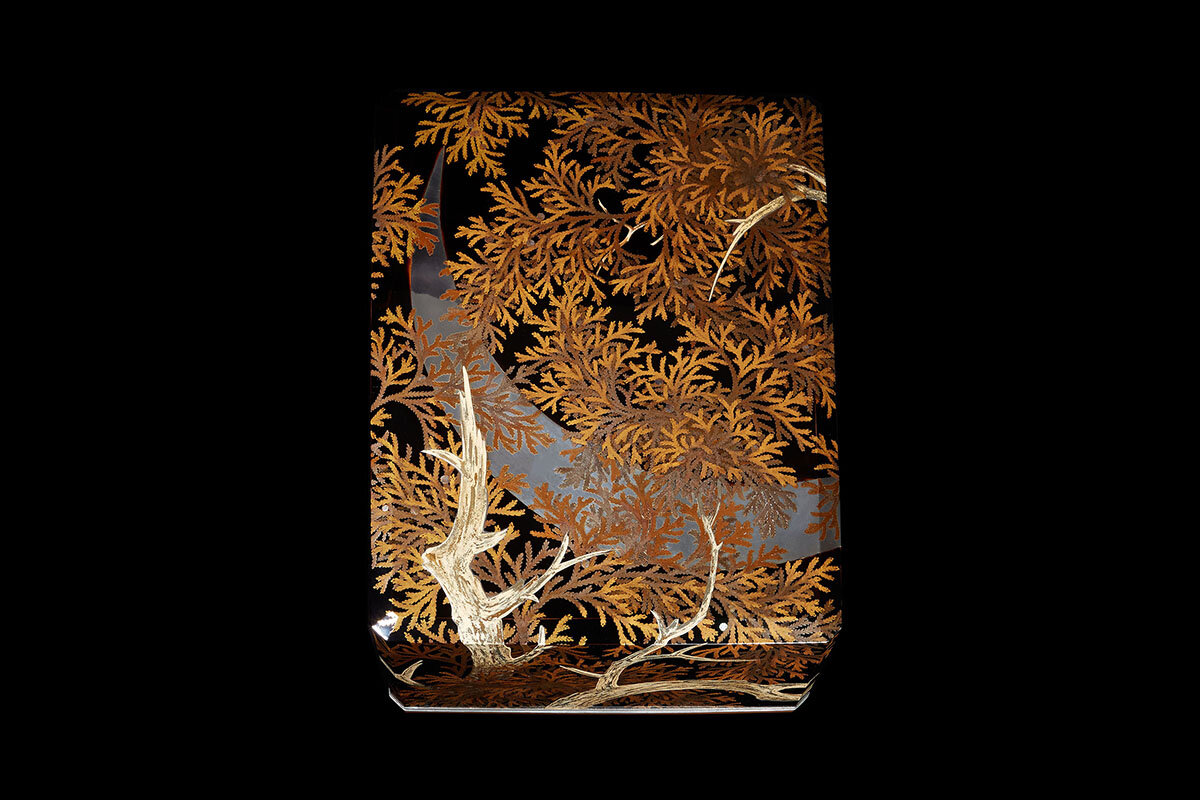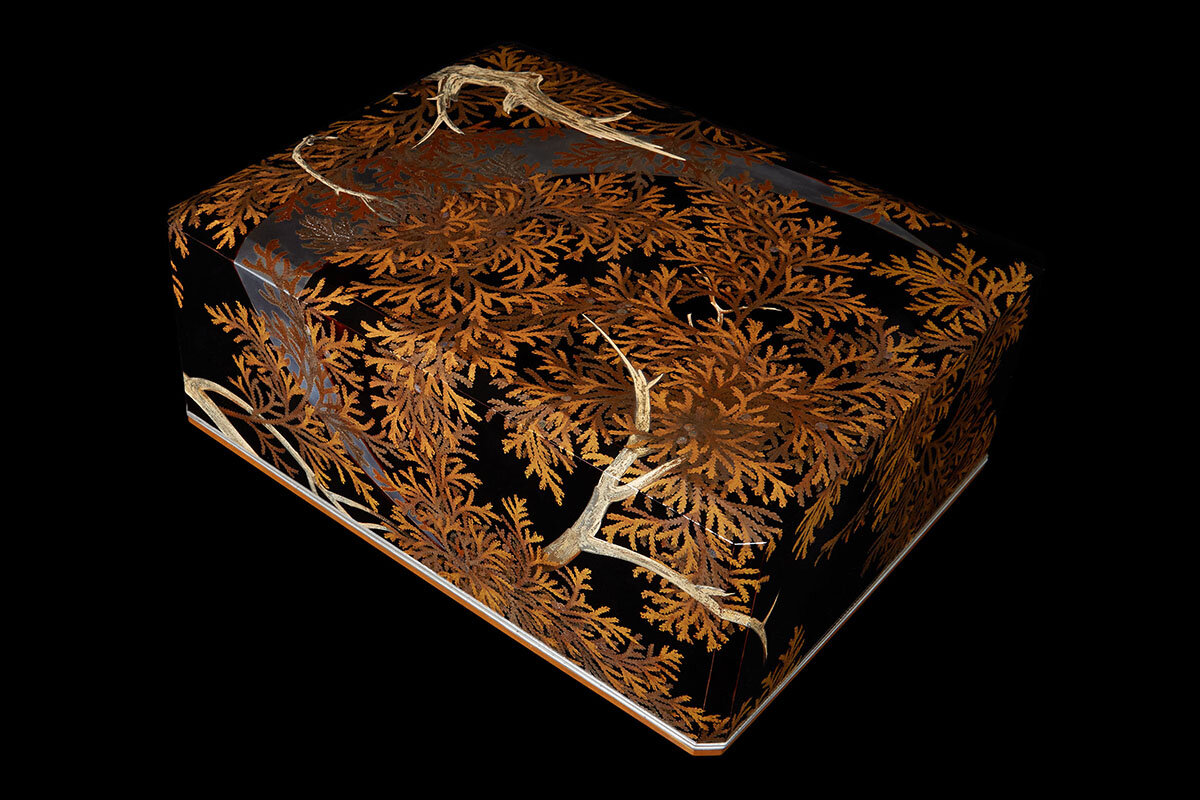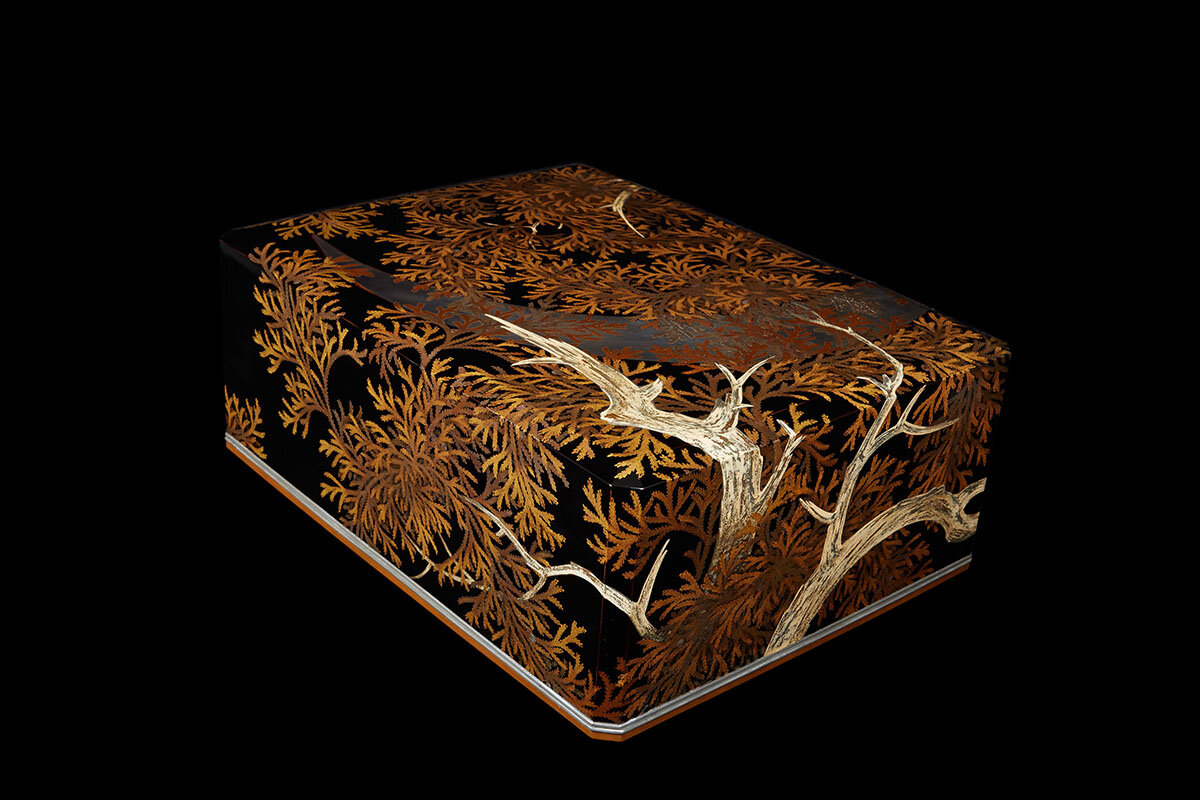ART DECO & MODERNISM
FUTAGI SEIHO 1938 EXHIBITION BOX
Bunko or stationery box in a large rectangular form beveled at the corners, ornamented with branches of hinoki cypress under a crescent moon in early summer. Of roiro or mirror-polished black lacquer, the hinoki branches of cream-colored titanium taka-maki-e raised lacquer overlaid in gold and silver lacquers; the cypress fronds of alternating silver and gold taka-maki-e; the pinecones of raden or inlaid blue-green mother-of-pearl; the moon of inlaid silver; the interiors of blue-grey lacquer ornamented with kinpaku scattered squares of orange-gold foil (gold foil lacquered with tamenuri to deepen the color) and gold nashiji dust of differing scale. With applied pewter rims. Signed on the reverse in raised gold lacquer against a roiro mirror-black ground: Seiho Yushinsai Saku or Made by Seiho Yushinsai (Futagi Seiho, the go or art name of Futagi Kazuyoshi; who additionally used the go Yushinsai; 1884 – 1954). Showa 13 or 1938.
With the tomobako or original box, inscribed on the exterior of the lid: Shoka Jogen no Tsuki Bunko or Stationery Box (with a design of an) Early Summer Crescent Moon; then signed on the lower left: Futagi Seiho Saku or Made by Futagi Seiho, and sealed. With the tomogire or original, sealed white silk wrapping cloth. On the interior floor of the box is applied the acceptance notice of this box for the Shin-Bunten exhibition in Showa 13, along with Futagi Seiho’s printed curriculum vitae as of 1938.
This lacquer stationery box was made for exhibition at the 2nd Shin-Bunten in Showa 13 or 1938, and it is illustrated in the Nittenshi, volume 13, page 383, number 158.
Born in Kanazawa, Futagi Seiho studied lacquer art under Yamamoto Toshinari, and later with the Kaga artists Itarashi Michisuke and Shimizu Kyubei. In 1921, Seiho won 3rd Place for his entry at the government-sponsored Noten exhibition; and in following years exhibited at the venue annually. In 1928, he was first accepted into the national art salons at the 9th Teiten. Thereafter, he showed at the 10th – 15th Teiten in 1929 – 1934; at the Bunten Kansaten in the autumn of 1936; at the 2nd Shin-Bunten in 1938; at the Hoshukuten in 1940; at the 5th Shin-Bunten in 1942. After the Pacific War he returned to the national exhibitions with the 2nd Nitten in 1946.
For other examples of his work, c.f. Kagedo’s catalogue Blue Wind, numbers 17, 19, and 34. See also Deco Japan: Shaping Art & Culture, 1920 – 1945, number 71, page 149; and number 121, page 210 for his exhibition lacquer at the 5th Shin-Bunten in 1942. Seiho’s lacquers are in the collections of the Ishikawa Prefectural Museum.
Futagi Seiho renders an early summer night in lacquer. We seem to stare up through cypress branches, waving gold or shadowed silver in the light of an immense crescent moon. The scale almost disorients, as we look down and imagine looking up. Elements contrast sharply, elegantly against one another: the mirror black of the sky, the brilliant silver arc, the crisply rendered but softly round leaves, even the bleached trunk and spiked branches of the tree. Glowing pearls of shell punctuate the foliage with pinecones. Unusually, the scene wraps the top and every side of the box with a three-dimensional reality. On the interior, a musical abstraction of glowing orange-gold squares and glittering dust dances across a pale evening blue.
Futagi Seiho 1938 Exhibition Box
Artist Name: Futagi Seiho
Period: Showa Pre War
Mediums: Lacquer
Form: Ornamental Boxes
Origin Country: Japan
6 7/8” high x 16 7/8” long x 13” wide
This piece is no longer available.








